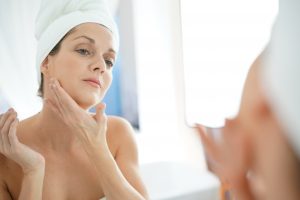Do you have thin skin that feels papery and is easily bruised or cut? If so, you’re not alone. Even though thin skin is typically associated with old age, it can actually happen at any age due to a number of factors. Below we’ll discuss the main causes of thin skin and how to thicken skin by using the best treatments for thin skin.

Layers of skin
Before we discuss what causes thin skin, it’s imperative to understand the three layers of skin: epidermis, dermis, and hypodermis. Each of these layers plays a role in the development of thin, fragile skin.
Epidermis
The epidermis is the outermost layer of skin. The part of the epidermis that is exposed to the external environment, the stratum corneum, consists of flat dead cells known as corneocytes that form a barrier to protect underlying tissue from infection, dehydration, chemicals, and mechanical stress. New epidermal skin cells, called keratinocytes, are formed in this layer through cell division to replace those shed continuously from the upper layers of the epidermis. This regenerative process is called skin cell renewal. As we age, the rate of cell renewal decreases.
Dermis
Beneath the epidermis is the dermis, which is composed of tough connective tissue as well as different types of cells and glands that have many important functions. The dermis contains blood vessels that provide nourishment and waste removal for both dermal and epidermal cells. The dermis also contains hair follicles, sweat glands, sebaceous glands, and nerves. Lastly, the dermis contains a structural network of collagen and elastin fibers embedded in an extracellular matrix. This is what gives the skin strength as well as elasticity.
Hypodermis
The hypodermis, also referred to as the subcutaneous tissue, is the third layer of skin that we are going to discuss. Made up of fat and connective tissue, this layer plays many important roles in your body. First, the hypodermis has a special connecting tissue known as fibrous bands that attach the dermis to your muscles and bones. There are also collagen and elastin fibers that attach this layer of skin to the dermis. Another function of the hypodermis is to store fat, which acts as an energy reserve, provides minor thermoregulation via insulation, and protects internal organs.
What causes thin skin?
Thin skin occurs due to changes in the three layers of skin. For example, when the growth and division of skin cells (cell renewal) in the epidermis begins to slow down, the skin will start to appear thin.
Another cause of thin skin is loss of the proteins collagen and elastin in the dermis. Collagen is a structural protein that is responsible for the resilience, strength, and durability of the skin. Elastin is a highly elastic protein that allows the skin to resume its shape after stretching or contracting. While collagen makes skin look plump and firm, elastin allows the skin to be elastic and pliable. The production of collagen declines with age: about 1 percent less collagen is produced in the skin each year after the age of 20. Moreover, environmental free radicals (from excessive UV exposure, pollution, cigarette smoke, chemicals, etc.) can degrade collagen and elastin. The result is thin, fragile skin.
Thin skin also occurs due to fat loss in the hypodermis. As you age, the more fat you lose in the hypodermis. Significant weight loss can also cause a decrease in the amount of fat in this layer of skin. This is problematic because as you lose volume, everything begins to slide down due to gravity. Over time, you’ll notice the development of sagging, thin skin. This not only looks unappealing, but can also result in injuries. Fatty tissue under your skin is important, as it acts as a buffer between the hard objects you come in contact with every day. Without this much-needed cushion, bumping up against a table may cause your skin to bruise or tear more easily.
Genetic factors also contribute to the development of thin skin. If your parents had thin skin, then you are more likely to have it. Even though you can’t do anything about the traits you inherit from your parents, you can still treat thin, fragile skin.
Treatment for thin skin
Treatment for thin skin and easy bruising depends on the area of the body where you have thin, fragile skin. The main areas are under the eyes, arms, and hands. Below we have specific treatment recommendations for each of these areas.
Thin skin under eyes
Thin skin under eyes is best treated with topical skin care products that protect and regenerate the skin. For instance, antioxidants like vitamin C and vitamin A (retinol) protect against collagen degradation while also stimulating collagen production. In addition, a broad spectrum SPF 30 sunscreen can be used to protect against further collagen degradation. You should also use ingredients that regenerate the skin and stimulate cell renewal. Examples include epidermal growth factors, alpha hydroxy acids, and peptides.
Thin skin on arms
The ingredients mentioned for treating thin skin under eyes can also be used for thin skin on arms. You can also use thicker, oil-based ingredients for thin skin on arms, like botanical oils, ceramides, cholesterol, fatty acids, and more. These ingredients will replenish the skin’s lipid barrier, which helps to prevent thin, fragile skin.
Thin skin on hands
All of the aforementioned ingredients can be used for thin skin on hands. It’s also important to adjust your lifestyle to prevent thin, fragile skin on your hands. For instance, if you frequently wash your hands, you may want to consider using a soap with gentle surfactants. Harsh soaps and surfactants can cause dryness and lead to thin skin. Another way to prevent thin skin on hands is to be extra cautious in the dry, winter months. The dry air with low humidity can lead to thin skin, so be sure to wear gloves and use thick emollients.







